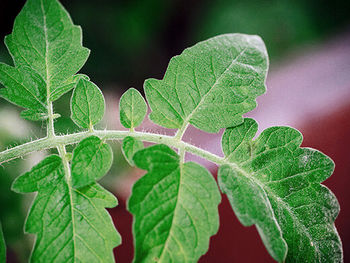Tomato Leaf
From Wikiwel
Other Names : Solanum lycopersicum, Lycopersicon esculentum, lycopersicum esculentum, Tomato Leaf extract, Tomato Leaf absolute, Tomato Leaf essential oil
Special Precautions of Tomato Leaf
- Tomato plant belongs to the family of nightshade. The tomato leaf can be UNSAFE. In large amounts, tomato leaves can cause poisoning. Symptoms of poisoning may include severe mouth and throat irritation, vomiting, diarrhea, dizziness, headache, mild spasms, and death in severe cases. But According to “Toxic Plants of North America” (Iowa State University Press, 2001), by George E. Burrows and Ronald J. Tyrl, a toxic dose of tomatine for an adult human would appear to require at least a pound of tomato leaves. These authors conclude that “the hazard in most situations is low.
- alkaloids/tomatine in the leaves would have skin irritating properties.
- The possible risks of tomatine for humans have not been formally studied, so no NOAEL can be deduced. The toxicity of tomatine has only been studied on laboratory animals. The symptoms of acute tomatine poisoning in animals are similar to the symptoms of poisoning by solanine, a potato glycoalkaloid. These symptoms include vomiting, diarrhea, abdominal pain, drowsiness, confusion, weakness, and depression. Generally, tomatine is regarded to cause less toxic effects to mammals than other alkaloids such as solanine. The amount of tomatine absorbed by the human body as well as the possible metabolism is unknown. There is no evidence that consumption of tomatoes causes acute toxic or genotoxic effects.
- The human consumption of moderate amounts of tomatine seems to occur without notable toxic effects. This is reinforced by the widespread consumption of “pickled green” and “fried green tomatoes” and the consumption of high-tomatine tomatoes (a variant of L. esculentum var. cerasiforme, better known as the "cherry tomato", indigenous to Peru) with very high tomatine content (in the range of 500–5000 mg/kg of dry weight).
- New York Times food science writer Harold McGee has found scant evidence for tomato toxicity in the medical and veterinary literature, and observes that dried tomato leaves (which contain higher concentrations of alkaloids than the fruits) are occasionally used as a food flavoring or garnish, without problems. He also reports that an adult human would probably have to eat over a pound of tomato leaves to ingest a toxic (not necessarily lethal) dose.
Health Benefits of Tomato Leaf
- Tomato leaves methanol extract possesses anti-inflammatory activity via inhibition of lipopolysacharide (LPS)-induced prostaglandin (PGE2)
- Cancer : Dr. Friedman has found that an extract of green tomato lowers the incidence of cancer in animals, and last month he reported that both this extract and purified tomatine inhibit the growth of various human cancer cells. Other studies have found that purified tomatine seems to stimulate the immune system in desirable ways.. The glycoalkaloid tomatine has been found to effectively kill or suppress the growth of human breast, colon, liver, and stomach cancer cells. This study suggests that consumers could benefit from eating high-tomatine green tomatoes, and that there may be a “need” to develop high-tomatine red tomatoes as well (for the treatment of cancer and/or the study of tomatine as an anti-carcinogenic and anti-viral agent).
- Cholesterol : In 2000, Dr. Friedman and colleagues reported that when lab animals ingest tomatine, essentially all of it passes through the animal unabsorbed. The alkaloid apparently binds to cholesterol in the digestive system, and the combination is excreted — ridding the body of both alkaloid and cholesterol. The researchers found that both tomatine-rich green tomatoes and purified tomatine lowered the levels of undesirable LDL cholesterol in animals.
- tomato leaf extract is used to treat incipient leprosy spots. (Suriname)
- Tomato leaf in mixture with castor oil in a paste is applied to filarial worm.
References
- Morris, S.C., Lee, T.H; The toxicity and teratogenicity of Solanaceae glycoalkaloids, particularly those of the potato (Solanum tuberosum): a review.; Food Techn. Aust., 1984; 118-124.
- Rick, C. M.; Uhlig, J. W.; Jones, A. D. (1994). "High alpha-tomatine content in ripe fruit of Andean Lycopersicon esculentum var. Cerasiforme: Developmental and genetic aspects". Proceedings of the National Academy of Sciences of the United States of America. 91 (26): 12877–12881. PMC 45543 Freely accessible. PMID 7809139. doi:10.1073/pnas.91.26.12877.
- Rick, C. M., Uhlig, J. W., Jones, A. D.; High R-tomatine content in ripe fruit of Andean Lycopersicon esculentum Var. cerasiforme: developmental and genetic aspects.; Proc. Natl. Acad. Sci., 1994; 91, 12877-12881.
- https://www.ncbi.nlm.nih.gov/pubmed/19514731
- Andersson, Christer.; Glycoalkaloids in tomatoes, eggplants, pepper and two Solanum species growing wild in the Nordic countries.; Nordic Council of Ministers, 1999.
- McGee, Harold (July 29, 2009). "Accused, Yes, but Probably Not a Killer". The New York Times. Retrieved 2016-11-03.
- https://www.ajol.info/index.php/ajb/article/view/98655
- https://www.ajol.info/index.php/ajb/article/view/98654
